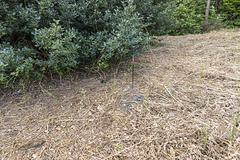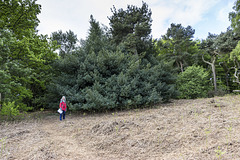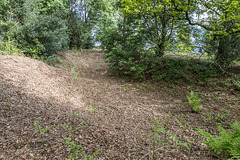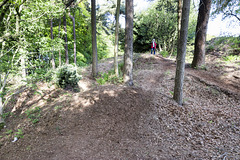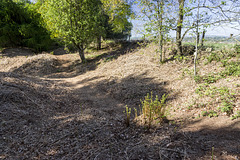
Mines, mining and quarrying
Folder: Mining and quarrying
Bole Hill Plantation - 'holly smelter' slag 2
| |
|
|
Limb Valley Bole Hill lead smelting site
A close-up view of a piece of slag from the 'holly smelter' site slag tip, adjacent to the stone-walled remains of what was almost certainly a lead smelting bole, high up on the northern edge of the Bole Hill Plantation in the Limb Valley, and possibly of 18th or early 19th century age. The slag has a ropy and porous, almost frothy texture, indicative of its former semi-molten condition.
A small square feature, depicting a building or structure of some sort appears on the 1st edition six-inch to one mile Ordnance Survey map published in 1854. It was probably disused even then, as the map shows the plantation all around it. Subsequent editions of the maps fail to show it, although curiously the feature has been resurrected on the latest OS maps, even though the structure has long since disappeared!
There are many 'Bole Hills' in Sheffield and along the west-facing sandstone and gritstone escarpments of the Eastern Edges. Their elevated locations were ideal for wind-blown furnaces ('boles') for smelting lead ore which was brought in by pack-horses from the Peak District mines further to the west.
Bole Hill Plantation - 'holly smelter' slag 1
| |
|
Limb Valley Bole Hill lead smelting site
A close-up view of a piece of slag from the 'holly smelter' site slag tip, adjacent to the stone-walled remains of what was almost certainly a lead smelting bole, high up on the northern edge of the Bole Hill Plantation in the Limb Valley, and possibly of 18th or early 19th century age. The slag has a ropy and porous, almost frothy texture, indicative of its former semi-molten condition.
A small square feature, depicting a building or structure of some sort appears on the 1st edition six-inch to one mile Ordnance Survey map published in 1854. It was probably disused even then, as the map shows the plantation all around it. Subsequent editions of the maps fail to show it, although curiously the feature has been resurrected on the latest OS maps, even though the structure has long since disappeared!
There are many 'Bole Hills' in Sheffield and along the west-facing sandstone and gritstone escarpments of the Eastern Edges. Their elevated locations were ideal for wind-blown furnaces ('boles') for smelting lead ore which was brought in by pack-horses from the Peak District mines further to the west.
Bole Hill Plantation - 'holly smelter' slag tip 2
| |
|
|
Limb Valley Bole Hill lead smelting site
A closer view of the small heap of slag adjacent to the 'holly smelter' site. The holly tree (just out of shot) is growing over the stone-walled remains of what was almost certainly a lead smelting bole, high up on the northern edge of the Bole Hill Plantation in the Limb Valley, and possibly of 18th or early 19th century age. The slag pieces have a ropy and porous, almost frothy texture, indicative of its former semi-molten condition.
A small square feature, depicting a building or structure of some sort appears on the 1st edition six-inch to one mile Ordnance Survey map published in 1854. It was probably disused even then, as the map shows the plantation all around it. Subsequent editions of the maps fail to show it, although curiously the feature has been resurrected on the latest OS maps, even though the structure has long since disappeared!
There are many 'Bole Hills' in Sheffield and along the west-facing sandstone and gritstone escarpments of the Eastern Edges. Their elevated locations were ideal for wind-blown furnaces ('boles') for smelting lead ore which was brought in by pack-horses from the Peak District mines further to the west.
Bole Hill Plantation - 'holly smelter' slag tip 1
| |
|
Limb Valley Bole Hill lead smelting site
The walking stick is located on a small heap of slag adjacent to the 'holly smelter' site on the left. The holly tree is growing over the stone-walled remains of what was almost certainly a lead smelting bole, high up on the northern edge of the Bole Hill Plantation in the Limb Valley, and possibly of 18th or early 19th century age.
A small square feature, depicting a building or structure of some sort appears on the 1st edition six-inch to one mile Ordnance Survey map published in 1854. It was probably disused even then, as the map shows the plantation all around it. Subsequent editions of the maps fail to show it, although curiously the feature has been resurrected on the latest OS maps, even though the structure has long since disappeared!
There are many 'Bole Hills' in Sheffield and along the west-facing sandstone and gritstone escarpments of the Eastern Edges. Their elevated locations were ideal for wind-blown furnaces ('boles') for smelting lead ore which was brought in by pack-horses from the Peak District mines further to the west.
Bole Hill Plantation - 'holly smelter' stone work
| |
|
Limb Valley Bole Hill lead smelting site
A panoramic view showing all that remains of the stone-work at the 'holly smelter' site. The holly tree is growing over the stone-walled remains of what was almost certainly a lead smelting bole, high up on the northern edge of the Bole Hill Plantation in the Limb Valley, and possibly of 18th or early 19th century age. The walking stick is 0.9 m long.
A small square feature, depicting a building or structure of some sort appears on the 1st edition six-inch to one mile Ordnance Survey map published in 1854. It was probably disused even then, as the map shows the plantation all around it. Subsequent editions of the maps fail to show it, although curiously the feature has been resurrected on the latest OS maps, even though the structure has long since disappeared!
There are many 'Bole Hills' in Sheffield and along the west-facing sandstone and gritstone escarpments of the Eastern Edges. Their elevated locations were ideal for wind-blown furnaces ('boles') for smelting lead ore which was brought in by pack-horses from the Peak District mines further to the west.
Bole Hill Plantation - 'holly smelter' site
| |
|
|
Limb Valley Bole Hill lead smelting site
The holly tree in the centre of the photo is growing over the stone-walled remains of what was almost certainly a lead smelting bole, high up on the northern edge of the Bole Hill Plantation in the Limb Valley, and possibly of 18th or early 19th century age.
A small square feature, depicting a building or structure of some sort appears on the 1st edition six-inch to one mile Ordnance Survey map published in 1854. It was probably disused even then, as the map shows the plantation all around it. Subsequent editions of the maps fail to show it, although curiously the feature has been resurrected on the latest OS maps, even though the structure has long since disappeared!
There are many 'Bole Hills' in Sheffield and along the west-facing sandstone and gritstone escarpments of the Eastern Edges. Their elevated locations were ideal for wind-blown furnaces ('boles') for smelting lead ore which was brought in by pack-horses from the Peak District mines further to the west.
Limb Valley Bole Hill disturbed ground 4
| |
|
|
Limb Valley Bole Hill lead smelting site
Disturbed, hummocky ground high up on the northern edge of the Bole Hill Plantation in the Limb Valley. Almost certainly the remains of lead smelting boles, dating back possibly to the 17th or 18th centuries.
There are many 'Bole Hills' in Sheffield and along the west-facing sandstone and gritstone escarpments of the Eastern Edges. Their elevated locations were ideal for wind-blown furnaces ('boles') for smelting lead ore which was brought in by pack-horses from the Peak District mines further to the west.
Limb Valley Bole Hill disturbed ground 3
| |
|
|
|
Limb Valley Bole Hill lead smelting site
Disturbed, hummocky ground high up on the northern edge of the Bole Hill Plantation in the Limb Valley. Almost certainly the remains of lead smelting boles, dating back possibly to the 17th or 18th centuries.
There are many 'Bole Hills' in Sheffield and along the west-facing sandstone and gritstone escarpments of the Eastern Edges. Their elevated locations were ideal for wind-blown furnaces ('boles') for smelting lead ore which was brought in by pack-horses from the Peak District mines further to the west.
Limb Valley Bole Hill disturbed ground 2
| |
|
|
|
Limb Valley Bole Hill lead smelting site
Disturbed, hummocky ground high up on the northern edge of the Bole Hill Plantation in the Limb Valley. Almost certainly the remains of lead smelting boles, dating back possibly to the 17th or 18th centuries.
There are many 'Bole Hills' in Sheffield and along the west-facing sandstone and gritstone escarpments of the Eastern Edges. Their elevated locations were ideal for wind-blown furnaces ('boles') for smelting lead ore which was brought in by pack-horses from the Peak District mines further to the west.
Limb Valley Bole Hill disturbed ground 1
| |
|
|
Limb Valley Bole Hill lead smelting site
Disturbed, hummocky ground high up on the northern edge of the Bole Hill Plantation in the Limb Valley. Almost certainly the remains of lead smelting boles, dating back possibly to the 17th or 18th centuries.
There are many 'Bole Hills' in Sheffield and along the west-facing sandstone and gritstone escarpments of the Eastern Edges. Their elevated locations were ideal for wind-blown furnaces ('boles') for smelting lead ore which was brought in by pack-horses from the Peak District mines further to the west.
Raasay: No.1 Ironstone Mine adit entrance (intake)…
| |
|
|
|
Raasay Ironstone Mine and Processing Works
A photo taken through the steel grille across the intake adit entrance of the Raasay No.1 Ironstone Mine, taken in April 2019. The concrete block walls extend just a short distance in, thereafter it is natural stone with few supports. There were two entrances for the No.1 Mine; this one allowed fresh air into the mine and was the main haulage road for ore. The link below shows the mine entrance in 1917.
The other adit for return (exhaust) air and its ventilation fan was located a short distance away.
Background
The two adits of Raasay No.1 ironstone Mine were situated about 2.5 km north of East Suisnish pier and worked the Jurassic (Upper Lias) age siderite and chamosite ores from 1914 to 1920. The mine was owned and developed by William Baird & Co. who also built the terraces of houses in the village of Inverarish to house the mine workers, many of whom were German prisoners of war. A tramway and incline connected the mine to the processing works (crusher, calcining kilns, gantries, loading hoppers) at East Suisnish.
A second pair of mine adits (Raasay No.2 Ironstone Mine) just north of Inverarish were also opened up around the same time but never went into proper production due to geological difficulties (faulting).
There was also a small amount of opencast outcrop mining carried out near the No.1 Mine, again around the same time.
The works were dismantled by 1943 but the site is now a scheduled protected monument.
A view of the No.1 Mine in 1917 is here:
geoscenic.bgs.ac.uk/asset-bank/action/viewAsset?id=1338
Raasay: No.1 Ironstone Mine adit entrance (intake)…
| |
|
|
Raasay Ironstone Mine and Processing Works
A closer view of the intake adit entrance of the Raasay No.1 Ironstone Mine, taken in April 2019. There were two entrances for the No.1 Mine; this one allowed fresh air into the mine and was the main haulage road for ore. The link below shows the mine entrance in 1917.
The other adit for return (exhaust) air and its ventilation fan was located a short distance away.
Background
The two adits of Raasay No.1 ironstone Mine were situated about 2.5 km north of East Suisnish pier and worked the Jurassic (Upper Lias) age siderite and chamosite ores from 1914 to 1920. The mine was owned and developed by William Baird & Co. who also built the terraces of houses in the village of Inverarish to house the mine workers, many of whom were German prisoners of war. A tramway and incline connected the mine to the processing works (crusher, calcining kilns, gantries, loading hoppers) at East Suisnish.
A second pair of mine adits (Raasay No.2 Ironstone Mine) just north of Inverarish were also opened up around the same time but never went into proper production due to geological difficulties (faulting).
There was also a small amount of opencast outcrop mining carried out near the No.1 Mine, again around the same time.
The works were dismantled by 1943 but the site is now a scheduled protected monument.
A view of the No.1 Mine in 1917 is here:
geoscenic.bgs.ac.uk/asset-bank/action/viewAsset?id=1338
Raasay: No.1 Ironstone Mine adit entrance (intake)…
| |
|
|
Raasay Ironstone Mine and Processing Works
This is the intake adit entrance of the Raasay No.1 Ironstone Mine, taken in April 2019. There were two entrances for the No.1 Mine; this one allowed fresh air into the mine and was the main haulage road for ore. The link below shows the mine entrance in 1917.
The other adit for return (exhaust) air and its ventilation fan was located a short distance away.
Background
The two adits of Raasay No.1 ironstone Mine were situated about 2.5 km north of East Suisnish pier and worked the Jurassic (Upper Lias) age siderite and chamosite ores from 1914 to 1920. The mine was owned and developed by William Baird & Co. who also built the terraces of houses in the village of Inverarish to house the mine workers, many of whom were German prisoners of war. A tramway and incline connected the mine to the processing works (crusher, calcining kilns, gantries, loading hoppers) at East Suisnish.
A second pair of mine adits (Raasay No.2 Ironstone Mine) just north of Inverarish were also opened up around the same time but never went into proper production due to geological difficulties (faulting).
There was also a small amount of opencast outcrop mining carried out near the No.1 Mine, again around the same time.
The works were dismantled by 1943 but the site is now a scheduled protected monument.
A view of the No.1 Mine in 1917 is here:
geoscenic.bgs.ac.uk/asset-bank/action/viewAsset?id=1338
Raasay: No.1 Ironstone Mine tramway with silver bi…
| |
|
|
Raasay Ironstone Mine and Processing Works
Just north of the viaduct in the previous photos, the No.1 Mine tramway is now overgrown with an attractive double lining of silver birch trees.
Background
The two adits of Raasay No.1 ironstone Mine were situated about 2.5 km north of East Suisnish pier and worked the Jurassic (Upper Lias) age siderite and chamosite ores from 1914 to 1920. The mine was owned and developed by William Baird & Co. who also built the terraces of houses in the village of Inverarish to house the mine workers, many of whom were German prisoners of war. A tramway and incline connected the mine to the processing works (crusher, calcining kilns, gantries, loading hoppers) at East Suisnish.
A second pair of mine adits (Raasay No.2 Ironstone Mine) just north of Inverarish were also opened up around the same time but never went into proper production due to geological difficulties (faulting).
There was also a small amount of opencast outcrop mining carried out near the No.1 Mine, again around the same time.
The works were dismantled by 1943 but the site is now a scheduled protected monument.
A view of the works in 1917 is here:
geoscenic.bgs.ac.uk/asset-bank/action/viewAsset?id=1343
Raasay: No.1 Mine tramway viaduct and tributary bu…
| |
|
|
Raasay Ironstone Mine and Processing Works
The No.1 Mine tramway had to cross the steep sided valley of a tributary of the Inverarish Burn on an impressive viaduct before heading south towards the processing plant at East Suisnish. Only the concrete support piers remain today. This is a view from the west.
Background
The two adits of Raasay No.1 ironstone Mine were situated about 2.5 km north of East Suisnish pier and worked the Jurassic (Upper Lias) age siderite and chamosite ores from 1914 to 1920. The mine was owned and developed by William Baird & Co. who also built the terraces of houses in the village of Inverarish to house the mine workers, many of whom were German prisoners of war. A tramway and incline connected the mine to the processing works (crusher, calcining kilns, gantries, loading hoppers) at East Suisnish.
A second pair of mine adits (Raasay No.2 Ironstone Mine) just north of Inverarish were also opened up around the same time but never went into proper production due to geological difficulties (faulting).
There was also a small amount of opencast outcrop mining carried out near the No.1 Mine, again around the same time.
The works were dismantled by 1943 but the site is now a scheduled protected monument.
A view of the works in 1917 is here:
geoscenic.bgs.ac.uk/asset-bank/action/viewAsset?id=1343
Raasay: No.1 Mine tramway viaduct - north pier
| |
|
|
Raasay Ironstone Mine and Processing Works
The No.1 Mine tramway had to cross the steep sided valley of a tributary of the Inverarish Burn on an impressive viaduct before heading south towards the processing plant at East Suisnish. Only the concrete support piers remain today. This is a view of the northern pier.
Background
The two adits of Raasay No.1 ironstone Mine were situated about 2.5 km north of East Suisnish pier and worked the Jurassic (Upper Lias) age siderite and chamosite ores from 1914 to 1920. The mine was owned and developed by William Baird & Co. who also built the terraces of houses in the village of Inverarish to house the mine workers, many of whom were German prisoners of war. A tramway and incline connected the mine to the processing works (crusher, calcining kilns, gantries, loading hoppers) at East Suisnish.
A second pair of mine adits (Raasay No.2 Ironstone Mine) just north of Inverarish were also opened up around the same time but never went into proper production due to geological difficulties (faulting).
There was also a small amount of opencast outcrop mining carried out near the No.1 Mine, again around the same time.
The works were dismantled by 1943 but the site is now a scheduled protected monument.
A view of the works in 1917 is here:
geoscenic.bgs.ac.uk/asset-bank/action/viewAsset?id=1343
Raasay: No.1 Mine tramway viaduct piers
| |
|
|
Raasay Ironstone Mine and Processing Works
The No.1 Mine tramway had to cross the steep sided valley of a tributary of the Inverarish Burn on an impressive viaduct before heading south towards the processing plant at East Suisnish. Only the concrete support piers remain today.
Background
The two adits of Raasay No.1 ironstone Mine were situated about 2.5 km north of East Suisnish pier and worked the Jurassic (Upper Lias) age siderite and chamosite ores from 1914 to 1920. The mine was owned and developed by William Baird & Co. who also built the terraces of houses in the village of Inverarish to house the mine workers, many of whom were German prisoners of war. A tramway and incline connected the mine to the processing works (crusher, calcining kilns, gantries, loading hoppers) at East Suisnish.
A second pair of mine adits (Raasay No.2 Ironstone Mine) just north of Inverarish were also opened up around the same time but never went into proper production due to geological difficulties (faulting).
There was also a small amount of opencast outcrop mining carried out near the No.1 Mine, again around the same time.
The works were dismantled by 1943 but the site is now a scheduled protected monument.
A view of the works in 1917 is here:
geoscenic.bgs.ac.uk/asset-bank/action/viewAsset?id=1343
Raasay: Tramway junction
| |
|
|
Raasay Ironstone Mine and Processing Works
This is the point where the No.2 Mine tramway joins the No.1 Mine tramway before heading south towards the processing plant at East Suisnish. The ruined building is the remains of the No.2 tramway winding house. The mountains of Skye are in the distance.
Background
The two adits of Raasay No.1 ironstone Mine were situated about 2.5 km north of East Suisnish pier and worked the Jurassic (Upper Lias) age siderite and chamosite ores from 1914 to 1920. The mine was owned and developed by William Baird & Co. who also built the terraces of houses in the village of Inverarish to house the mine workers, many of whom were German prisoners of war. A tramway and incline connected the mine to the processing works (crusher, calcining kilns, gantries, loading hoppers) at East Suisnish.
A second pair of mine adits (Raasay No.2 Ironstone Mine) just north of Inverarish were also opened up around the same time but never went into proper production due to geological difficulties (faulting).
There was also a small amount of opencast outcrop mining carried out near the No.1 Mine, again around the same time.
The works were dismantled by 1943 but the site is now a scheduled protected monument.
A view of the works in 1917 is here:
geoscenic.bgs.ac.uk/asset-bank/action/viewAsset?id=1343
The No.2 Mine entrances in 1917 are shown here:
geoscenic.bgs.ac.uk/asset-bank/action/viewAsset?id=1341
Jump to top
RSS feed- Latest items - Subscribe to the latest items added to this album
- ipernity © 2007-2024
- Help & Contact
|
Club news
|
About ipernity
|
History |
ipernity Club & Prices |
Guide of good conduct
Donate | Group guidelines | Privacy policy | Terms of use | Statutes | In memoria -
Facebook
Twitter




